Extreme temperatures have become a critical health risk for millions of workers worldwide, with rising productivity losses and increased accidents. The WHO’s first report on this subject since 1969 showcases the pressing need for urgent action and adaptation strategies as climate change fuels more frequent and severe heat events, threatening worker safety and well-being.
As climate change propels a rise in extreme heat events, the World Health Organization (WHO) has issued a crucial report outlining the escalating risks faced by workers, particularly in indoor and outdoor occupations such as construction and agriculture, where heat exhaustion can severely hinder performance and safety.
The WHO, in conjunction with the World Meteorological Organization, highlights that a significant number of workers are currently exposed to harmful heat stress, which can lead to serious health complications including heat strokes, kidney failure, and dehydration. The report reflects a growing trend of dangerous heatwaves, with notable record temperatures prompting urgent calls for preventative cooperation among employers, governments, and labor unions.
Recent statistics add gravity to the situation, revealing that each degree Celsius increase in temperature beyond 20°C correlates with a 2% drop in productivity, while accidents surge by 7% at temperatures exceeding 30°C. In response, several countries in Europe, including Italy and Switzerland, have initiated strategies to protect workers by ceasing work during peak heat hours and signing protocols with labor representatives.
Additionally, the WHO’s focus extends beyond the workforce, recognizing that vulnerable populations, such as the elderly and chronically ill, are also disproportionately affected during heatwaves. Educational institutions, particularly in Germany, are adapting by allowing for "Hitzefrei" or heat-free days when temperatures become too extreme for students to learn effectively.
As schools return to session amidst soaring temperatures, educators are increasingly voicing concerns over inadequate facilities to ensure safe learning environments, prompting calls for improved ventilation systems and climate control measures in school buildings. The WHO urges all stakeholders to engage in collaborative efforts to address these changes while also making a financial investment in the future of education and workplace safety.
The implications of ignoring the necessity for adaptation as global temperatures continue to rise may prove costly. As Rüdiger Krech of the WHO strongly advocates, the time to act is now; failing to prioritize investment in safety measures may result in higher productivity losses and health complications in the long run. Stakeholders are encouraged to rethink strategies, including uniform redesigns and infrastructural investments, to mitigate heat stress risks in workplaces and academic settings effectively.
As climate change propels a rise in extreme heat events, the World Health Organization (WHO) has issued a crucial report outlining the escalating risks faced by workers, particularly in indoor and outdoor occupations such as construction and agriculture, where heat exhaustion can severely hinder performance and safety.
The WHO, in conjunction with the World Meteorological Organization, highlights that a significant number of workers are currently exposed to harmful heat stress, which can lead to serious health complications including heat strokes, kidney failure, and dehydration. The report reflects a growing trend of dangerous heatwaves, with notable record temperatures prompting urgent calls for preventative cooperation among employers, governments, and labor unions.
Recent statistics add gravity to the situation, revealing that each degree Celsius increase in temperature beyond 20°C correlates with a 2% drop in productivity, while accidents surge by 7% at temperatures exceeding 30°C. In response, several countries in Europe, including Italy and Switzerland, have initiated strategies to protect workers by ceasing work during peak heat hours and signing protocols with labor representatives.
Additionally, the WHO’s focus extends beyond the workforce, recognizing that vulnerable populations, such as the elderly and chronically ill, are also disproportionately affected during heatwaves. Educational institutions, particularly in Germany, are adapting by allowing for "Hitzefrei" or heat-free days when temperatures become too extreme for students to learn effectively.
As schools return to session amidst soaring temperatures, educators are increasingly voicing concerns over inadequate facilities to ensure safe learning environments, prompting calls for improved ventilation systems and climate control measures in school buildings. The WHO urges all stakeholders to engage in collaborative efforts to address these changes while also making a financial investment in the future of education and workplace safety.
The implications of ignoring the necessity for adaptation as global temperatures continue to rise may prove costly. As Rüdiger Krech of the WHO strongly advocates, the time to act is now; failing to prioritize investment in safety measures may result in higher productivity losses and health complications in the long run. Stakeholders are encouraged to rethink strategies, including uniform redesigns and infrastructural investments, to mitigate heat stress risks in workplaces and academic settings effectively.
















